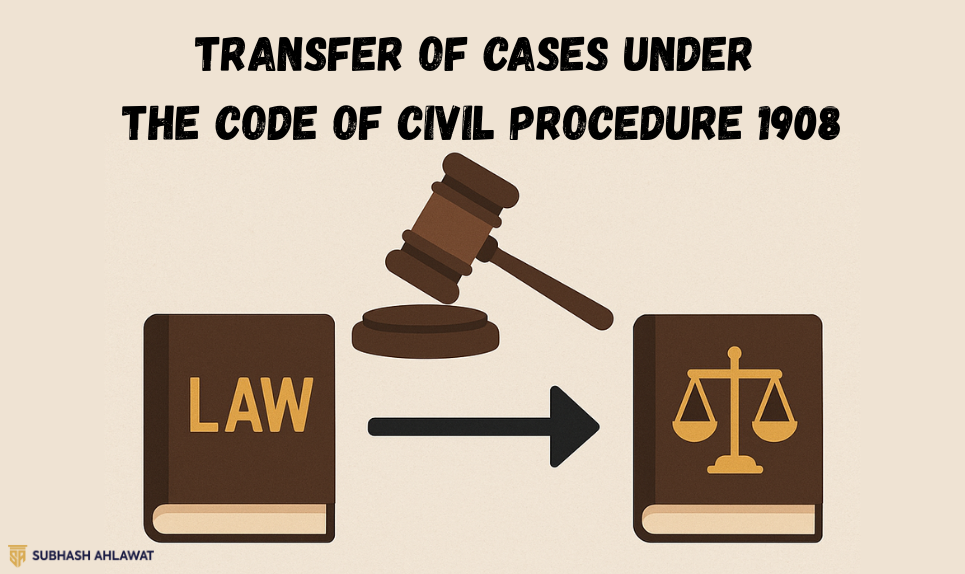Transfer of Cases Under the Code of Civil Procedure 1908

Courts aim to give every person a fair, quick, and low-cost trial. But many times a suit begins in one court and later needs to move to another. A party may feel the place is unfair, witnesses live far away, or a related case is already pending elsewhere. To keep justice smooth, the Code of Civil Procedure, 1908 (CPC) lays down clear rules for transfer of civil cases.
What does “transfer of case” mean?
A transfer shifts an already-filed suit, appeal or other civil proceeding from the court where it sits now to some other court that is also legally able to try it. The receiving court then carries on from the same stage; the old court steps out.
Why might anyone want a transfer?
Fair hearing – A party fears local bias, influence or hostility.
Convenience – Reduces travel time for parties and witnesses in legal proceedings.
Speed – One court’s docket is lighter, so the matter moves faster.
Consolidation – Two similar suits in two places can be combined.
Administrative order – A higher court manages work flow by grouping similar disputes.
Courts repeat that transfer is not a routine right. Strong facts must show that moving the file will better serve the “ends of justice”.
The Statutory Frame: Sections 22 to 25 Code of Civil Procedure
Section 22 – Choice between two competent courts
If a suit could legally be filed in either of two or more courts, the defendant may, before settlement of the first issue, ask the court to move the suit to the other court. The request must be filed in writing, and the plaintiff must be notified.
Section 23 – Where to file the request
Section 23 specifies which court hears the transfer plea:
When the courts lie under the same High Court, the application goes to that High Court.
When the courts are in different States, the application goes to the Supreme Court.
Section 24 – General Power of High Courts and District Courts
Section 24 is the real work-horse. At any stage of any civil proceeding, the High Court or a District Court may:
Request the transfer of a case from one subordinate court to another.
Withdraw a case to itself and either try it or send it down to a proper court.
The court has discretion to act on its own initiative (suo motu) or based on a party's motion. Recent High Court orders stress that this power is broad but must be used sparingly so that forum shopping is discouraged.
Tip: Even appeals filed in a Commercial Division may not come within Section 24(5); courts examine competence carefully.
Section 25 – Supreme Court’s national power
Under Section 25, the Supreme Court may transfer any suit, appeal, or proceeding from a High Court or civil court in one State to another State’s court if it deems such transfer necessary to serve the interests of justice. The standard is stringent yet adaptable. Most petitions involve matrimonial fights, company disputes spread across States, or questions of public interest.
Who may apply?
Power | Who files? | Typical timing |
S. 22 | Defendant | Before the court frames issues |
S. 24 | Any party or the court | Any time during the case |
S. 25 | Any party | Any time; often soon after notice is served |
Grounds the courts usually accept
Real risk of biased trial – e.g., one party holds sway in the local bar or media.
Threat to safety – Witnesses fear intimidation at the present venue.
Multiple connected suits – Consolidation prevents conflicting judgments.
Distance and cost – Long travel for many witnesses when another court is nearer.
Health or special hardship – Elderly or differently-abled litigant.
Bare inconvenience or mere fear of an adverse ruling is insufficient.
Procedure step-by-step
Drafting the petition
Heading: Name the section (22, 24 or 25) and parties.
Facts: Identify the suit, stage and both courts.
Grounds: State clear, specific reasons.
Prayer: The exact transfer sought.
Affidavit: Verification of facts.
Filing and notice
Pay the proper court-fee.
Serve notice on the opposite party.
Include postal receipts or proof of e-service.
Hearing
Each side argues convenience and justice.
The court may call for a lower-court record.
Order
Allowed – suit transferred; lower court must send records within a set time.
Rejected – suit continues where filed; costs may follow.
For a flawlessly drafted transfer petition, engage Advocate Subhash Ahlawat, Faridabad's top-ranking civil advocate.
Costs and delay considerations
Courts can impose costs to discourage frivolous motions. They also watch for dilatory tactics; if a party seeks transfer mainly to stall the suit, the petition is dismissed quickly with costs.
Impact of transfer on proceedings already taken
Section 24(3) confirms that prior steps – pleadings, evidence recorded – stay valid unless the new court decides otherwise. This protects work already done and avoids waste.
Important Judicial Guidelines
Maneka Sanjay Gandhi v. Rani Jethmalani, 1979 – The Court said the first rule is a fair trial. A suit moves only when there is real fear that justice will fail at the old place. Mere comfort or “easy lawyers” is not enough.
Sumita Singh v. Kumar Sanjay, 2001 – In family fights the wife’s hardship matters most. Here the wife worked 1,100 km away from the husband’s court. The judges shifted the case to her city so she could attend.
Amita Shah v. Virender Lal Shah, 2003 – The wife also cared for a small child. The Court said the child’s welfare made transfer “a must”. The divorce suit moved from Delhi to a hill-town near her home.
Gupte Cardiac Care Centre v. Olympic Pharma Care, 2004 – Two money suits came from one machine deal, one in Nashik and one in Delhi. To avoid clashing orders, the Court sent the later Delhi suit to Nashik and tried both together.
NIMHANS v. C. Parameshwara, 2005 – The Court explained that Section 10 (stay of a later suit) applies only to civil suits, not to labour or writ cases. So a labour dispute could not halt the civil recovery suit; no transfer was needed.
State Bank of India v. Ranjan Chemicals, 2006 – Bank action in the Debt-Recovery Tribunal and a company’s civil suit were two sides of one coin. The civil suit was moved to the Tribunal so one forum could decide everything at once
Kulwinder Kaur v. Kandi Friends Education Trust, 2008 – The judges called Section 24 power “very wide”. But they set aside a transfer made without giving reasons, stressing that courts must show why moving a case helps “the ends of justice.”
Jaimala Chuphal v. Vivek Bisht, 2025 – The latest example: wife, child-support case and criminal case all lay in Bareilly, while the husband’s divorce case was in Punjab. The Supreme Court again moved the divorce suit to the wife’s town, noting that video court links could still help both sides.
Together these rulings teach two simple lessons: courts move cases only to protect fair hearing or to join connected matters, and they give special care where a weaker party—often the wife or smaller litigant—would suffer at the old venue.
Practical drafting tips
Be factual, not emotional. Attach proof: medical papers, distance charts, police reports.
File early: Delay weakens the plea unless events after filing create new hardship.
Address the balance: Show why transfer is fair to both sides, not just convenient for you.
Suggest a clear forum: Courts dislike open-ended prayers like “any other court”.
Check territorial competence: The proposed court must already have jurisdiction under the CPC or special Act.
Common mistakes that sink a petition
Vague allegations of bias without names, events or documents.
Copy-paste grounds used in unrelated matrimonial cases.
Hiding parallel suits in other States; once revealed, credibility drops.
Ignoring procedural rules of the concerned High Court or Supreme Court (e.g., mandatory synopsis, index).
Filing under Section 24 when the current and desired courts fall under different High Courts – only the Supreme Court can help there.
Special Contexts
Matrimonial disputes
Transfers dominate the Supreme Court’s civil docket because statutes often allow filing where wife lives, husband lives, or marriage took place. The Court now relies on video-conferencing directions to balance the scales. Yet where children, safety or severe financial hardship exist, physical transfer is still common.
Commercial suits
After the Commercial Courts Act, 2015, many High Courts hold that transfers must respect the Act’s time limits and the specialised nature of commercial divisions. Parties therefore face a higher bar.
Interaction with video-conference hearings
Since the pandemic, High Courts often solve distance inconvenience by allowing virtual evidence instead of moving the suit. Litigants should address why virtual mode will not cure their hardship.
Frequently asked questions
Q: Can a defendant seek transfer after evidence is recorded?
Yes, but the court will require compelling reasons because delay is greater.
Q: Is there a limitation period to file a Section 24 petition?
No fixed limit, but courts prefer it before trial starts.
Q: Does a transferred suit start afresh?
No. The new court picks up at the same stage unless it decides otherwise.
Conclusion
Transfer of cases under the CPC is a balancing act between a litigant’s convenience and the justice system’s need for stable forums. Sections 22 to 25 furnish a graded scheme: from defendant-led motions between neighbouring courts all the way up to the Supreme Court’s nation-wide power. Modern case law shows that courts wield these sections carefully, approving transfers only when clear evidence proves that justice truly demands a new venue. By grounding your petition in concrete facts, following procedural rules, and respecting the other side’s position, you improve the odds that the court will agree to move – or keep – the case in the place where fairness shines brightest.


